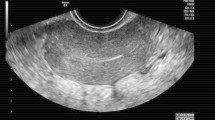Abstract
Introduction
The aim of this study was to evaluate the criteria of endometrial thickness to detect retained products of conception following first trimester spontaneous abortion or elective pregnancy termination.
Methods
This was a retrospective study on 116 patients who underwent uterine re-evacuation with a diagnosis of retained products of conception based on clinical and sonographic findings. Pathologic reports of samples obtained during re-evacuation were reviewed for the presence of gestational tissue. Endometrial thickness determined by transvaginal sonography and certain clinical features (gestational age and interval between initial curettage and re-evacuation, which may affect presence or absence of gestational tissue, parity, indication for initial curettage) were noted. The sensitivity and specificity of sonographic measurement of endometrial thickness for detecting retained products of conception were assessed.
Results
Histopathologic reports confirmed the diagnosis of retained products of conception in 66 of 116 patients (56.9%). Percentage of nulliparity and the time elapsed between initial curettage and re-evacuation were significantly high in patients with retained products of conception. The sensitivity and specificity of endometrial thickness greater than 13 mm for detecting retained products of conception were 85 and 64%, respectively.
Conclusion
An endometrial thickness of 13 mm or more, detected by transvaginal sonography, has the best diagnostic efficiency for detection of retained products of conception following first trimester spontaneous abortion or elective pregnancy termination.
Similar content being viewed by others
References
Nielsen S, Hahlin M (1995) Expectant management of first-trimester spontaneous abortion. Lancet 345:84–6
Luise C, Jermy K, Collons WP, Bourne TH (2002) Expectant management of incomplete, spontaneous first-trimester miscarriage: outcome according to initial ultrasound criteria and value of follow-up visits. Ultrasound Obstet Gynecol 19(6):580–2
Moodliar S, Bagratee JS, Moodley J (2005) Medical vs. surgical evacuation of first-trimester spontaneous abortion. Int J Gynaecol Obstet 91(1):21–6
Maslovitz S, Almog B, Mimouni GS, Jaffa A, Lessing JB, Many A (2004) Accuracy of diagnosis of retained products of conception after dilation and evacuation. J Ultrasound Med 23(6):749–56
Debby A, Malinger G, Harow E, Golan A, Glezerman M (2006) Transvaginal ultrasound after first-trimester uterine evacuation reduces the incidence of retained products of conception. Ultrasound Obstet Gynecol 27(1):61–4
Brown DL (2005) Pelvic ultrasound in the postabortion and postpartum patient. Ultrasound Q 21(1):27–37
Rulin MC, Bornstein SG, Campbell JD (1993) The reliability of ultrasonography in the management of spontaneous abortion, clinically thought to be complete: a prospective study. Am J Obstet Gynecol 168(1 Pt 1):12–5
Sawyer E, Ofuasia E, Ofili-Yebovi D, Helmy S, Gonzalez J, Jurkovic D (2007) The value of measuring endometrial thickness and volume on transvaginal ultrasound scan for the diagnosis of incomplete miscarriage. Ultrasound Obstet Gynecol 29(2):205–9
Durfee SM, Frates MC, Luong A, Benson CB (2005) The sonographic and color Doppler features of retained products of conception. J Ultrasound Med 24(9):1181–6
Sadan O, Golan A, Girtler O, Lurie S, Debby A, Sagiv R et al (2004) Role of sonography in the diagnosis of retained products of conception. J Ultrasound Med 23(3):371–4
Cowett AA, Cohen LS, Lichtencerg ES, Stika CS (2004) Ultrasound evaluation of the endometrium after medical termination of pregnancy. Obstet Gynecol 103(5): 871–5
Wong SF, Lam MH, Ho LC (2002) Transvaginal sonography in the detection of retained products of conception after first-trimester spontaneous abortion. J Clin Ultrasound 30(7): 428–32
Kurtz AB, Shlansky-Goldberg RD, Choi HY, Needleman L, Wapner RJ, Goldberg BB (1991) Detection of retained products of conception following spontaneous abortion in the first trimester. J Ultrasound Med 10(7):387–95
Author information
Authors and Affiliations
Corresponding author
Rights and permissions
About this article
Cite this article
Ustunyurt, E., Kaymak, O., Iskender, C. et al. Role of transvaginal sonography in the diagnosis of retained products of conception. Arch Gynecol Obstet 277, 151–154 (2008). https://doi.org/10.1007/s00404-007-0436-z
Received:
Accepted:
Published:
Issue Date:
DOI: https://doi.org/10.1007/s00404-007-0436-z




